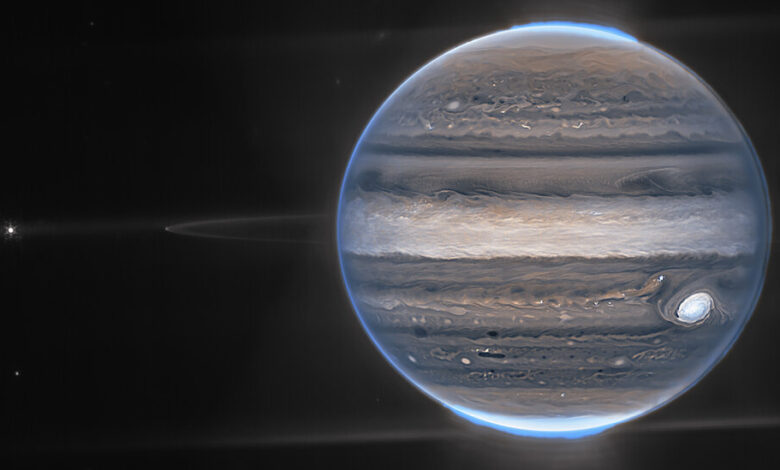How the Webb Telescope Expanded My Universe

I have a confession to make: I underestimated the James Webb Space Telescope.
For years, as NASA struggled to build the designated successor to the Hubble Space Telescope, I came to think of the Webb as a problem child, ever-delayed, swallowing dollars that could have gone to other telescopes and space missions.
The telescope was not named for some sky-breaking astronomer. Rather it carried the name of a bureaucrat, the former NASA Administrator James Webb, who oversaw the Apollo program to land on the Moon but also tolerated the purging of gay and lesbian people when he was a high official at the State Department. It was an infrared telescope, which would give astrophysicists a new angle on what was going on out there, but I didn’t think it could have the impact Hubble had.
I was wrong.
This has been the summer of Webb. Hardly a week has gone by without the news media being graced by another spectacular image or tentative but striking measurement of the infrared universe. It has captured faint distant galaxies that surprisingly floated into view when the astronomers were still trying to focus the telescope, the billowing clouds of the Carina nebula star factory, the enchanting Cartwheel Galaxy and other spiral galaxies that seemed to be ringed with Mardi Gras beads.
The latest images, released Monday, hit closer to home. As captured by the Webb’s infrared senses, Jupiter, king of our own planetary realm, glows like a disco ball. The new images revealed details astronomers hadn’t expected to see around the guardian of the solar system, including two of the giant planet’s smaller moons Amalthea and Adrastea. The telescope also picks up Jupiter’s faint rings, which are only one-millionth the brightness of Jupiter itself, against a backdrop of even fainter and farther galaxies. Bright auroras at the planet’s North and South Poles produce a crowning haze of light.

A NIRCam composite image of Jupiter with three filters, F360M (red), F212N (yellow-green) and F150W2 (cyan), with alignment due to the planet’s rotation.Credit…NASA, ESA, CSA, Jupiter ERS Team; image processing by Judy Schmidt
“We really hadn’t expected it to be this good, to be honest,” Imke de Pater, an astronomer at the University of California, Berkeley who headed the Jupiter work, said in a news release. The new observations, she added, “will allow us to study the interplay of dynamics, chemistry and temperature structure in and above the Great Red Spot and the auroral regions.”
What I got wrong was that I overlooked how bigthe telescope was. Yes, its infrared capability gives it an edge in seeing galaxies so far away and back in time. But in addition to that, the Webb’s primary mirror, about seven meters in diameter, dwarfs any other telescope in space and most on the ground, rendering it 10 times as powerful as the Hubble, allowing it to pull in fainter and fainter galaxies from all epochs of cosmic time — from here to almost infinity.
Underscoring this cosmic reach was another spectacle that The Cosmic Evolution Early Release Science Survey, a team of astronomers led by Steven L. Finkelstein of the University of Texas in Austin, released last week. It is the result of 690 different images of a patch of sky about one-tenth the size of a full moon, according to Dr. Finkelstein. Combined, they are the equivalent of looking up through a soda straw at 13.5 billion years of history.
How many straws do you need to take in a universe? Even a single straw is a porthole into the mystery of existence. It is full of galaxies — 30,000 of them, according to Dr. Finkelstein — in all shapes, sizes and colors, strung out in time and space — islands of creation where something might have happened or is happening now in remote lonely splendor.
By zooming in on the survey image, you can sail through this space as if you are on the spaceship that Carl Sagan traveled in on the show “Cosmos.”
The deeper you go, the more you see: So many clouds of stars, lonely magistrates of mystery. Some of these galaxies, it has been suggested but not yet confirmed, date from the earliest days of the luminous universe, when the fog of the Big Bang was lifting 200 million or 300 million years after it flicked on the switch of existence.
Whatever happens or happened in these galaxies or any other pinwheeled wonders, I suspect, stays there, lost in space and within the limits of our imagination. Looking through Webb’s new void, I was overwhelmed by trying to imagine what forms life and matter might take out there. Could we ever know or even imagine what is possible in the cosmological horn of plenty depicted in the Webb images?
I haven’t been so entranced with a view of the heavens for a long time. I remember when I was a teenager shivering with my friends around a dwindling campfire high in the Cascade Mountains in Washington one crystal clear night, debating the fate of the universe. The stars, so bright, were like a revelation to a cloud-bound youth. I spent hours staring up at the stars, striving for some sort of visceral experience of how far they were. But you can’t measure your stride against a light-year, let alone a million or billion of them. It broke my imagination.
Now it’s been broken again.